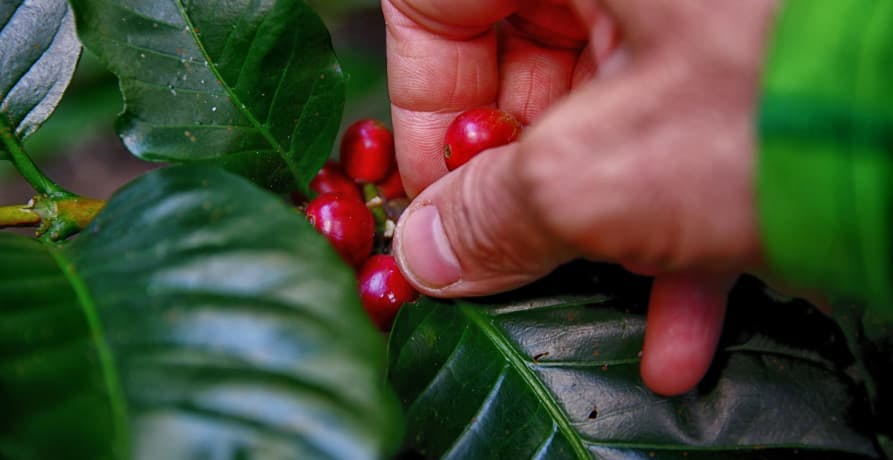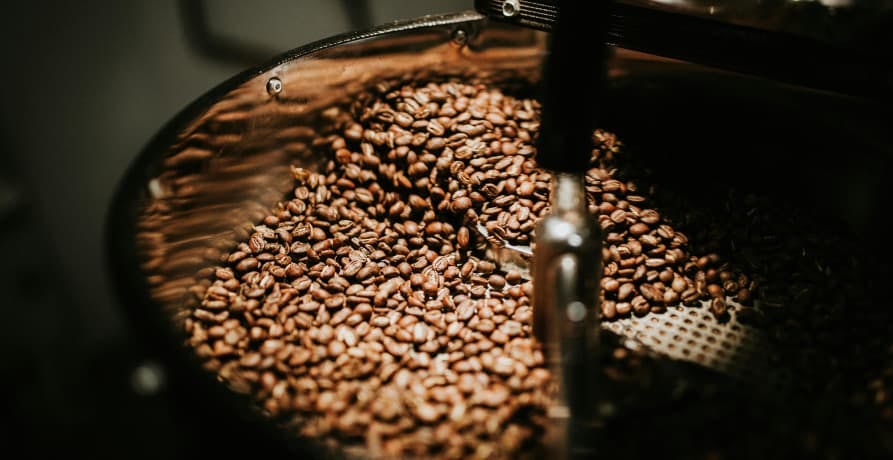ESG / CSR
Industries
Is coffee threatened by climate change?



Wake up and smell the coffee - it’s under threat from climate change! This article delves into how a warming planet is impacting coffee cultivation and production. We'll examine the effects of climate change on growing conditions, what this means for the future of your favourite morning ritual, and how you can help make a difference.
👉 In this article, we explore how climate change is threatening the future of coffee production and what this means for the future of your favourite drink.
How is coffee grown and produced?
Coffee - one of the world's most beloved beverages - begins its journey from the seed of the Coffea plant. There are over 120 species of Coffea, but two main varieties dominate the market - Arabica and Robusta.
Arabica, which is known for its smooth, complex flavour profiles, accounts for about 70% of the world's coffee production and prefers higher altitudes and cooler climates. Robusta, on the other hand, is more bitter, contains more caffeine, and grows in warmer, wetter climates at lower altitudes.
Planting and cultivation
The process of coffee cultivation starts with the planting of coffee seeds in large beds in shaded nurseries. After sprouting, the seedlings are moved to individual pots where they are grown until they are ready to be planted in the field - a process that typically takes around one year. Once transplanted, it takes a further 3 to 4 years for the young coffee plants to bear fruit (referred to as coffee cherries).
Harvesting
In flatter countries such as Brazil, machines can be used to speed up the process of picking the coffee cherries, but in most countries, they are picked by hand - a very labour-intensive method. The timing of the harvest is key - cherries that are not picked at the right time can negatively impact the quality of the coffee. Most regions have one major harvest a year, though countries like Colombia, which have more consistent weather year-round, can have two.
Processing
Once harvested, the cherries undergo processing to extract the beans. There are two main methods: dry and wet. The dry method is the traditional method and most simple, it involves drying the cherries in the sun over a period of several weeks. The wet method involves removing the pulp from the coffee cherry after harvesting so that the bean is dried with only the parchment skin left on. This method is quicker and improves the acidity and overall quality of the coffee.
Drying and milling
Once processed, the coffee beans are dried to achieve just the right moisture level for roasting - an important step that needs close attention to avoid spoilage. After drying, the beans go through the milling process, where they're freed from the parchment layer if they were wet-processed, or stripped of the entire dried husk if dry-processed.
Exporting
The milled beans are now referred to as green coffee and are graded and sorted based on size and weight. They are typically tested for quality and taste - a process known as cupping. After approval, they are packed and shipped around the world.
Roasting
Before being sold to consumers, green coffee is roasted at different levels depending on the desired flavour. Roasting transforms the chemical and physical properties of green coffee beans into roasted coffee products. The roasting process is what produces the characteristic flavour of coffee that is well-loved around the world.

How does climate change affect coffee production?
Alarmingly for coffee lovers, climate change poses a significant threat to global coffee production, with its impacts being felt from the cultivation stage right through to the yield and quality of the coffee beans produced. As global temperatures rise and weather patterns become more erratic, the traditional coffee-growing regions within the ‘coffee belt’ (a loop around the planet, falling between the Tropics of Cancer and Capricorn) are experiencing shifts that could potentially reshape the entire industry.
Temperature increases
Coffee plants - particularly Arabica - require specific conditions to thrive. Arabica grows best in mild temperatures ranging from 18°C to 22°C while robusta thrives between 22 and 28℃. However, rising global temperatures are pushing these ideal conditions beyond the traditional altitudes and latitudes where coffee has historically been grown.
Higher temperatures can also accelerate the metabolism and growth rate of coffee plants, reducing the maturation period of the coffee cherry, which impacts the development of flavours in the beans. What’s more, excessive heat can lead to increased evapotranspiration, stressing plants and making them more susceptible to diseases.
Changes in rainfall patterns
Coffee production is heavily dependent on regular rainfall - particularly in regions that rely on natural downpours instead of irrigated water. Climate change is disrupting these patterns, resulting in longer droughts mixed with heavier rainfall. Drought conditions can dehydrate coffee plants and erode the quality of the soil, while excessive rainfall can lead to fungal diseases such as coffee leaf rust and cherry rot, which impact yield and quality.
Increased pests and diseases
The warmer and wetter climates created by climate change are perfect environments for pests and pathogens that affect coffee plants. One of the most devastating is the coffee borer beetle, which bores into coffee cherries to lay eggs, with the emerging larvae consuming the coffee bean inside. Similarly, coffee leaf rust, a fungal disease that causes defoliation and significant yield loss, is on the rise due to warmer and damper conditions. These pests and diseases not only reduce yields but also increase the cost of production, as more resources are needed for pest and disease management.
Impact on coffee farmers
The effects of climate change on coffee production have significant implications for millions of coffee farmers, particularly smallholders who might not have the resources to combat these changes. Many are facing reductions in crop yield and quality, which directly affect their incomes and livelihoods. This situation is exacerbated in countries where coffee represents a major portion of the economy and exports.
Quality and supply of coffee
As the climate continues to change, the flavour profile of coffee is also at risk. The stress conditions under which coffee is grown can alter the chemical makeup of the coffee beans, affecting flavour, aroma, and acidity. This doesn't just affect your coffee experience - it could also alter market dynamics as some regions struggle to produce high-quality beans.
What’s more, is that a significant portion of the world's coffee is being produced in climate-vulnerable regions. This means that global supply chains are at risk of disruption, potentially leading to increased coffee prices and supply shortages - not great news for fans of the caffeinated drink.
How is climate change affecting coffee growing regions?
The effects of climate change on coffee production can vary significantly across regions, but some general trends can be identified across major coffee-growing regions within the coffee belt - this includes well-known coffee-producing countries such as Brazil, Colombia, Mexico, Peru, Ethiopia, Indonesia, and Vietnam.
Latin America
In countries like Brazil (the largest coffee producer in the world), climate change is leading to increased temperatures and altered patterns of rainfall. In Brazil, regions traditionally known for their coffee cultivation are experiencing reduced rainfall and higher temperatures, which affects the bloom and fruit development stages of coffee plants.
Meanwhile, in neighbouring Colombia, warmer temperatures are allowing coffee pests like the coffee berry borer to thrive at higher altitudes. The shift in climate is forcing farmers to consider higher altitudes for cultivation, where the conditions are cooler but where terrain and infrastructure may not be ideal.
Africa
East Africa, particularly Ethiopia - which is the origin of Arabica coffee - is also facing challenges from erratic rainfall patterns and rising temperatures. These changes threaten the genetic diversity of wild coffee species found in Ethiopian forests, which are crucial for developing resistant varieties. Furthermore, the increased frequency of droughts is making water resources scarce, complicating irrigation and processing methods that are vital for coffee production.
Asia
In Southeast Asia, particularly in Vietnam (the world's second-largest coffee producer and a major grower of Robusta), changes in weather patterns are impacting coffee production. Increased rainfall and temperatures are contributing to the spread of diseases like leaf rust and pests that were previously not a major concern. The unpredictability of rain also affects the timing of cultivation and harvesting, leading to lower yields and quality.
Central America
Central American countries, including Guatemala and Honduras, have been hit hard by coffee leaf rust, which has been exacerbated by higher temperatures and humidity levels. The region has also experienced hurricanes and heavy rainfall that not only destroys crops but also leads to increased soil erosion - reducing nutrients in the earth that are essential for coffee growth.
The impact on quality and yield
Across these regions, the variability in climate conditions is leading to significant fluctuations in coffee yield and quality. The stress conditions under which the coffee plants are grown are altering the biochemical composition of the coffee beans. This affects the flavour profiles, which are crucial for the specialty coffee market that relies on consistency and distinct characteristics.
Furthermore, the adaptation measures required to cope with these changes often involve financial investments that are beyond the reach of many small-scale farmers, potentially leading to decreased market competitiveness and economic vulnerability.

What are the impacts of reduced coffee supply?
The impacts of climate change on coffee production extend far beyond the farms and fields, they also affect the global economy and communities dependent on coffee farming. As climate change disrupts coffee production, both the economic stability of entire regions and the livelihoods of millions of smallholder farmers are at stake.
Economic implications
- Global coffee market - As coffee yields decrease and quality becomes inconsistent due to climate change, the supply of coffee will begin to fluctuate more unpredictably. This volatility can lead to significant variations in coffee prices, affecting the entire supply chain from farmers to consumers. Higher prices may benefit farmers if they can maintain yields and quality, but more often, the increased costs of adaptation and loss of crops outweigh these benefits.
- Increased production costs - Adapting to new growing conditions often requires investment in new farming technologies, irrigation systems, and crop varieties. For many coffee producers, particularly smallholders, these costs are prohibitive. The economic burden can lead to increased debt or force farmers out of coffee production altogether, leading to reduced global diversity in coffee production and potential monopolisation by larger businesses that can afford to adapt.
- Export revenues - In many coffee-growing countries, coffee is a significant export commodity. Changes in the volume and quality of coffee due to climate impacts can affect national economies, reducing export revenues and affecting currency stability. For countries like Ethiopia and Honduras, where coffee constitutes a major part of the export economy, the stakes are particularly high. 👉 In Ethiopia, coffee accounts for 4 to 5% of the country’s GDP, and 40% of its exports.
Social implications
- Community displacement and urban migration - As rural livelihoods based on coffee farming become unsustainable, there is likely to be an increase in migration from rural to urban areas. This migration is often driven by the search for more stable employment, which can lead to overpopulation in cities and increased poverty rates in urban areas.
- Loss of traditional livelihoods - For many communities, coffee farming is not just an economic activity but a cultural heritage. The loss of coffee farming due to climate change can lead to a loss of cultural identity and traditional knowledge, which has been passed down through generations.
- Social instability - Economic hardships due to failing coffee yields can lead to increased social instability. In regions where the economy is heavily dependent on agriculture, such instability can exacerbate issues like crime, political unrest, and social discontent.
- Food security - In many coffee-growing regions, farmers rely on intercropping coffee with food crops. Disruptions in coffee production can jeopardise food security for these farmers and their communities, compounding the challenges posed by climate change.

What can be done to mitigate the effects of climate change on coffee production?
As the coffee industry grapples with the challenges posed by climate change, both local and global stakeholders are deploying a variety of strategies to mitigate its impacts. These initiatives range from on-the-ground adaptations by farmers to international collaborations aimed at enhancing the resilience of the coffee sector as a whole.
On-farm adaptations
- Diversification of crops - Many coffee farmers are diversifying their crops to reduce dependency on coffee alone, which helps stabilise income and enhance food security. Intercropping with food crops or other cash crops can buffer farmers against coffee price volatility and provide sustenance if coffee crops fail.
- Improved agricultural practices - Farmers are adopting more sustainable agricultural practices to combat the effects of climate change. For example, agroforestry (integrating trees into coffee farms) provide shade for coffee plants, reduces temperature extremes, and increases biodiversity. Other practices involve soil conservation techniques to prevent erosion, enhance water retention, and improve soil health.
- Use of resistant varieties - Research institutions and agricultural organisations are developing and distributing climate-resilient coffee varieties. These new strains are bred to be more tolerant of heat and drought and resistant to emerging pests and diseases.
Technological innovations
- Water management technologies - As water becomes scarcer and less predictable, efficient water use through drip irrigation and rainwater harvesting systems is becoming more important. These technologies help to manage water use more effectively, ensuring that crops can be irrigated during dry spells without wasting scarce water resources.
- Data-driven farming - Precision agriculture technologies, including the use of satellite imagery and farm management software, enable farmers to make better-informed decisions about planting, irrigating, and harvesting. These tools help optimise resource use and improve yields even under changing climatic conditions.
Industry-wide initiatives
- Supply chain collaboration - Coffee companies, NGOs, and governments are collaborating more than ever to support farmers. Programs that provide training, financial assistance, and access to better resources are being implemented. Starbucks, for example, has committed to significant sustainability goals, including comprehensive support for coffee farmers facing climate change.
- Certification programs - Certification schemes like Fair Trade and Rainforest Alliance are promoting sustainable farming by setting standards that encourage environmentally friendly farming practices and offering premium prices to producers who abide by these standards.
- Research and development - There is an increased investment in research focusing on everything from new agricultural practices to genetic studies of coffee plants. Institutions like World Coffee Research are at the forefront, working on creating varieties and techniques that can sustain coffee farming in a changing climate.
Global policy and advocacy
- Advocacy for climate action - The coffee industry is also using its influence to advocate for broader climate action. By raising awareness of how climate change impacts coffee production, industry leaders are pushing for policy changes and international agreements that aim to reduce global carbon emissions and support agricultural adaptation efforts.
These strategies collectively aim to create a more resilient coffee industry capable of withstanding the challenges posed by climate change. By implementing adaptive measures, leveraging technology, and fostering collaboration across sectors, the coffee industry seeks not only to survive but to thrive in the face of global changes.
How can you contribute towards sustainable coffee consumption?
Climate change is stirring up challenges for coffee production, but there's good news - your choices can make a real difference. Opting for sustainable coffee and reducing waste not only helps mitigate environmental impacts but also supports coffee communities striving for resilience. By making mindful choices, we can contribute to sustaining our beloved brew and the people who produce it.
- Opt for certified coffee - One of the most impactful actions individuals can take is to choose coffee that is certified by recognised sustainability organisations like Fair Trade and Rainforest Alliance. These certifications not only ensure that the coffee is grown under environmentally friendly practices but also support social equity by providing better conditions and fair wages for farmers. This helps them invest in more sustainable and resilient farming practices.
- Support local and small-scale farmers - Purchasing coffee from local roasters who source their beans from small-scale farmers can also contribute to sustainability. These roasters often have direct relationships with the farmers, ensuring that more of the profit returns to the communities that grow the coffee. This direct trade model can encourage and financially support the adoption of sustainable practices at the farm level.
By making informed decisions about coffee purchases and reducing waste, you can help secure the future of your favourite drink. While these actions may seem small, they can collectively influence major shifts toward sustainable practices within the coffee industry. Not only do these efforts help protect the environment, but they also support the livelihoods of coffee farmers worldwide, ensuring that our beloved coffee remains available and enjoyable for years to come.
What about Greenly?
At Greenly we can help you to assess your company’s carbon footprint, and then give you the tools you need to cut down on emissions. Why not request a free demo with one of our experts - no obligation or commitment required.
If reading this article has inspired you to consider your company’s own carbon footprint, Greenly can help. Learn more about Greenly’s carbon management platform here.




